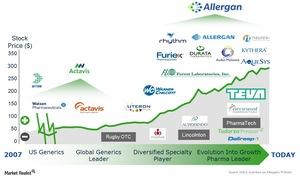What Is Allergan’s Inorganic Growth Strategy?
Actavis acquired Allergan in March 2015, and the company changed its name from Actavis to Allergan (AGN).
July 7 2016, Updated 2:32 p.m. ET

Allergan’s growth strategy
Actavis acquired Allergan in March 2015, and the company changed its name from Actavis to Allergan (AGN). The company has entered an agreement with Teva Pharmaceuticals (TEVA) for the divestiture of Allergan’s Generic Pharmaceutical business to Teva.
Allergan calls its new industry model “growth pharma.” It’s based on identifying five characteristics that make the company grow at a higher rate and differentiate it from its peers, which are the big pharma companies growing at a slower pace.
Changes in recent years
With the target of becoming a new leader in pharmaceuticals, Actavis, now Allergan, has undergone many small and large acquisitions and divestitures in recent years apart from the Actavis-Allergan merger. The recent acquisitions and divestitures include the following:
- The company acquired Topokine Therapeutics, a topical dermatology company focused on non-invasive fat reduction products in April 2016. The deal strengthens the company’s aesthetics portfolio and its pipeline.
- The company acquired Kythera, a company focused on aesthetics, in October 2015.
- The company acquired Oculeve, a company focused on products for dry eyes, in August 2015.
- The company divested its respiratory business, which was acquired as a part of the Forest Laboratories transaction, to AstraZeneca (AZN).
- The company divested Aptalis Pharmaceutical Technologies, also known as Pharmatech, which was acquired as a part of the Forest Laboratories transaction.
Pfizer (PFE) and Allergan had announced the potential merger of the companies in November 2015. However, due to the actions of the US Department of Treasury for the adverse tax change, the deal was terminated in April 2016.
Investors can consider ETFs like the Health Care Select Sector SPDR ETF (XLV), which holds ~3.4% of its total assets in Allergan, or the Vanguard Growth ETF (VUG), which holds ~1.0% of its total assets in Allergan, in order to divest company-specific risk.
